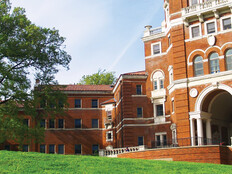3 Reasons Your Campus Wi-Fi is Slow
In higher education, when Wi-Fi isn’t working as expected, an institution’s support lines light up and social media feeds are filled with complaints. Problems can escalate quickly, leaving universities and colleges scrambling to find a fix.
But figuring out why your campus Wi-Fi is slow, or not working at all, isn’t always easy.
“A lot of institutions simply don’t know what the cause is and they spend a lot of time trying to diagnose and troubleshoot, which is a very difficult thing,” explains James Wiley, analyst for Eduventures.
But as CIOs and experts will tell you, understanding the common reasons for Wi-Fi problems can help higher-education institutions fix problems quickly and future-proof their wireless networks — keeping connection problems (and student complaints) at bay.
1. You Need to Update Access Point Technology and Density
The proliferation of Wi-Fi-enabled devices on campus continues to grow, especially in residence spaces where students have cell phones, tablets, laptops, Wi-Fi-enabled TVs and gaming consoles.
If you don’t have enough access points, or the ones you have are more than three years old, you likely don’t have the capacity to handle the demands of all these devices.
Mur Muchane, CIO at Wake Forest University in North Carolina, says replacing outdated access points and increasing the density of access points can help.
Last summer, Wake Forest replaced 800 access points in campus residences with 2,500 next-generation APs, dramatically increasing density and improving Wi-Fi performance.
Muchane says, in an informal student survey taken after the project, students had overwhelmingly positive comments about Wi-Fi accessibility.
“It was a big institutional investment, but we recognize that that’s where all of this is headed,” says Muchane.
2. Ghost Applications and Devices Are Clogging Up Wi-Fi
Keeping track of everything that’s using your Wi-Fi network and planning accordingly is no easy feat — especially when you aren’t aware of ghost applications and ghost devices that may be using your network.
Ghost applications and devices clogging up campus Wi-Fi can include:
- Student-created servers
- Rogue programs installed by staff and faculty without IT approval
- Wi-Fi-enabled Internet of Things devices, like door monitors, etc.
Wiley says wireless surveys, also known as RF site surveys, along with Wi-Fi monitoring tools and services can help you detect ghost devices and applications.
Mark Henderson, CIO of the University of Illinois at Urbana-Champaign, has worked with his team to update 6 million square feet of wireless coverage on the campus over the past three years. He says monitoring may be expensive, but it makes understanding the health of your wireless network infinitely easier.
“Because of all the extensive monitoring we do, we’re able to understand the health of various aspects of the wireless networks … and we can do something proactively instead of waiting for our faculty, staff and students to be the proverbial canary in the coal mine.”
3. Your Bandwidth Needs a Boost
At the University of Richmond in Virginia, a project to upgrade campus Wi-Fi started with boosting bandwidth.
“Wireless eventually rides on your wired connection, so we want to make sure we update our cable plan throughout the institution as well,” explains university CIO Keith McIntosh.
“We make sure we renovate and upgrade the cable. After that we go back and update the Wi-Fi access points,” explains McIntosh.
Muchane agrees that making sure your bandwidth is sufficient is essential to the health of your Wi-Fi network. He says Wake Forest has a 10 gigabit connection, which means even during peak hours when plenty of students are streaming Netflix. “All that infrastructure has to connect with campus bandwidth, so you have to be sized right from the size of your pipe to the internet,” explains Muchane.









